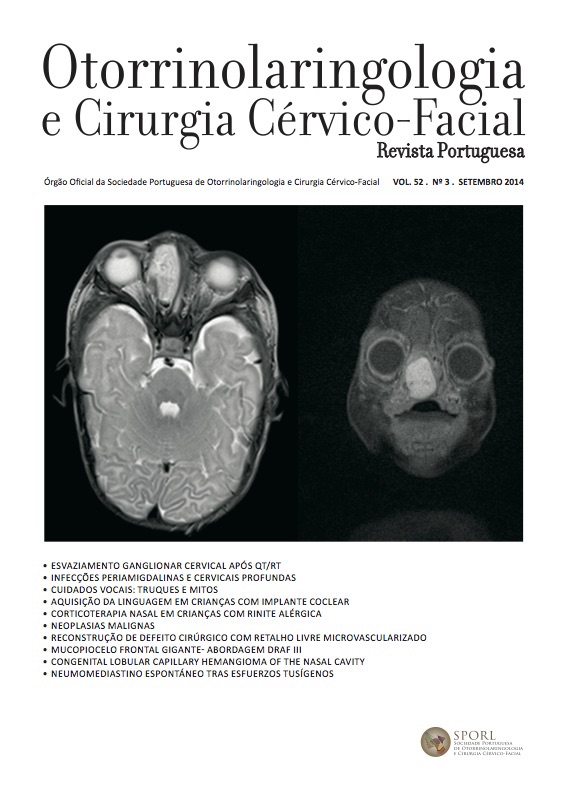Reconstruction of surgical defect with microvascular free flap by otolaryngologists
DOI:
https://doi.org/10.34631/sporl.452Keywords:
vascular microsurgery, otolaryngologists, microvascular free flap, radial forearm free flap, training, head and neck surgeryAbstract
Introduction: The reconstruction of surgical defects after tumor resection in head and neck oncological surgery uses various techniques, which should preferably be performed at the same time. At the top of the so-called “Reconstructive ladder” are the Microvascular free flaps. Usually performed by plastic surgeons, any obstacle to their access should not preclude other surgeons, working in the field of head and neck surgery, the ability to offer their patients this type of reconstruction. Thus, one can see increasingly, the mastery of these techniques by surgeons with different training areas, including otolaryngologists.
Methods: Clinical case report and literature review
Results: We present the case of a 47-year-old patient with a squamous-cell carcinoma of the left tonsil (pT2N2b) to whom we proposed a partial pharyngectomy with reconstruction with radial forearm free flap. Two senior surgeons of the ENT Department of the IPOLFG (Portuguese Oncological Institute at Lisbon) with extensive experience in oncological head and neck surgery, but without experience as primary surgeons in microvascular reconstruction, developed a prior preparation program that included training sessions with cadaver forearm free flap raising and vascular anastomosis in laboratory rats. The surgery was performed in September 2011 with chemoradiotherapy in November and December 2011 and with good viability of the flap to date and good functional results.
Conclusions: With proper training and preparation, reconstruction with microvascular free flaps can (and should) be achieved by otolaryngologists dedicated to head an neck surgery
Downloads
References
Wei F-C, Mardini S. Flaps and Reconstructive Surgery. W B Saunders Co; 2009. p. 638.
Hurvitz KA, Kobayashi M, Evans GRD. Current Options in Head and Neck Reconstruction. Plastic and Reconstructive Surgery. 2006 Oct. 1;118(5):122e–133e.
Shah JP, Patel SG. Head and Neck Surgery and Oncology, Third Edition. 3rd ed. Mosby; 2003. p. 736.
Jacobson JH, Suarez EL. Microvascular Surgery. Chest. 1962 Feb. 1;41(2):220–224.
Tamai S. History of Microsurgery. Plastic and Reconstructive Surgery. 2009 Dec.;124:e282–e294.
Yang GF, Chen PJ, Gao YZ, Liu XY, et al. Classic reprint Forearm free skin flap transplantation: a report of 56 cases. British journal of plastic surgery. Elsevier; 1997;50(3):162–165.
Soutar DS, Scheker LR, Tanner NS, McGregor IA. The radial forearm flap: a versatile method for intra-oral reconstruction. British journal of plastic surgery. 1983 Jan.;36(1):1–8.
Wolff K-D, Hölzle R, Holzle F. Raising of Microvascular Flaps. Springer Verlag; 2011. p. 200.
Martins PNA, Montero EF de S. Basic microsurgery training: comments and proposal. Acta Cir Bras. 2007;22(1):79–81.
Balasundaram I, Aggarwal R, Darzi LA. Development of a training curriculum for microsurgery. British Journal of Oral & Maxillofacial Surgery. British Association of Oral and Maxillofacial Surgeons; 2010 Dec. 1;48(8):598–606.
Cigna E, Bistoni G, Trignano E, Tortorelli G, et al. Microsurgical teaching: Our experience. Journal of plastic, reconstructive & aesthetic surgery : JPRAS. Elsevier Ltd; 2010 Jun. 1;63(6):e529–e531.
Petruzzelli GJ, Brockenbrough JM, Vandevender D, Creech SD. The influence of reconstructive modality on cost of care in head and neck oncologic surgery. Arch Otolaryngol Head Neck Surg. 2002 Dec.;128(12):1377–1380.
Funk GF, Karnell LH, Whitehead S, Paulino A, et al. Free tissue transfer versus pedicled flap cost in head and neck cancer. Otolaryngology - Head and Neck Surgery. 2002 Sep.;127(3):205–212.
De Bree R, Reith R, Quak JJ, Uyl-De Groot CA, et al. Free radial forearm flap versus pectoralis major myocutaneous flap reconstruction of oral and oropharyngeal defects: a cost analysis. Clinical otolaryngology : official journal of ENT-UK ; official journal of Netherlands Society for Oto-Rhino-Laryngology & Cervico-Facial Surgery. 2007 Aug.;32(4):275–282.
Spiegel JH, Polat JK. Microvascular Flap Reconstruction by Otolaryngologists: Prevalence, Postoperative Care, and Monitoring Techniques. Laryngoscope. 2007 Mar.;117(3):485–490.
Luginbuhl AJ, Pribitkin EA, Krein H, Heffelfinger RN. Assessment of microvascular anastomosis training in otolaryngology residencies: Survey of United States program directors. Otolaryngology - Head and Neck Surgery. Elsevier Inc.; 2010 Nov. 1;143(5):633–636.
Biglioli F, Liviero F, Frigerio A, Rezzonico A, et al. Function of the sensate free forearm flap after partial glossectomy. Journal of cranio-maxillo-facial surgery : official publication of the European Association for Cranio-Maxillo-Facial Surgery. 2006 Sep. 1;34(6):332–339.






